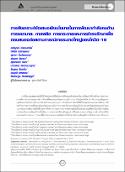บทคัดย่อ
การวิจัยแบบผสมผสานครั้งนี้ มีวัตถุประสงค์เพื่อสังเคราะห์ข้อเสนอเชิงนโยบายในการพัฒนากำลังคนด้านการพยาบาล: การผลิต การกระจายและการธำรงรักษาเพื่อตอบสนองต่อสถานการณ์การระบาดใหญ่ของโควิด-19 เก็บรวบรวมข้อมูลจากกลุ่มตัวอย่างเชิงปริมาณจำนวน 396 คนด้วยแบบสอบถามการธำรงรักษากำลังคนทั้งที่เป็นปัจจุบันและแนวทางที่ต้องการให้เกิดด้านการพยาบาลเพื่อตอบสนองต่อสถานการณ์การระบาดของโรคระบาดใหญ่ (โควิด-19) และข้อมูลเชิงคุณภาพจำนวน 120 คนจากการสัมภาษณ์เชิงลึก ผลการศึกษา 1) ก่อนการระบาด พบการผลิตเป็นไปตามจำนวนที่สถาบันวางไว้ การเรียนการสอนเป็นการเผชิญหน้าในชั้นเรียน การกระจายกำลังคนยังอยู่เฉพาะที่โรงพยาบาลขนาดใหญ่ การธำรงรักษายังไม่เหมาะสมกับภาระงาน 2) ขณะที่มีการระบาด พบการผลิตยังคงเป็นไปตามจำนวนเดิมแต่มีการปรับกิจกรรมการเรียนการสอนให้เหมาะสมกับมาตรการการป้องกันโควิด-19 มีการเรียนออนไลน์และการเรียนในห้องปฏิบัติการพยาบาล มีการกระจายกำลังคนด้านวิชาชีพพยาบาลเพื่อไปใช้ในการดูแลผู้ป่วยทั้งในโรงพยาบาลและโรงพยาบาลสนาม การธำรงรักษามีการจัดสวัสดิการและค่าเสี่ยงภัย 3) หลังการระบาด เสนอว่า แผนการผลิตควรเน้นผลิตพยาบาล ที่ทำหน้าที่ได้หลากหลาย มีทักษะที่จำเป็นต่อสถานการณ์การเปลี่ยนแปลง และควรคัดเลือกผู้เรียนที่มีภูมิลำเนาในท้องถิ่น ให้เข้ามาเรียนเพื่อแก้ปัญหาการขาดแคลนและป้องกันการย้ายกำลังคนออกจากพื้นที่ การกระจายกำลังคนทางการพยาบาลควรกระจายให้ครอบคลุมในระดับปฐมภูมิ ทุติยภูมิและตติยภูมิ และการธำรงรักษาควรมีการบรรจุพยาบาลด้วยค่าตอบแทนที่เหมาะสมกับภาระงานเสี่ยงภัยที่เพิ่มขึ้น และดูแลสวัสดิการต่างๆ 4) ข้อเสนอเชิงนโยบายในการพัฒนากำลังคนด้านการพยาบาล ด้านการผลิตควรวางแผนการผลิตในระยะยาวตามความต้องการที่แท้จริงของระบบบริการสุขภาพของประเทศ ด้านการกระจายควรทบทวนและวางแผนกระจายอัตรากำลังด้านการพยาบาลของสถานบริการสุขภาพอย่างเป็นระบบทั้งในระดับกระทรวง เขตบริการสุขภาพ และสถานบริการสุขภาพทุกระดับให้มีอัตรากำลังอย่างเหมาะสมตามความแตกต่างกันตามบริบทพื้นที่และตามความต้องการบริการของประชาชนและระดับความซับซ้อนของการให้บริการพยาบาล ด้านการธำรงรักษาควรกำหนดแนวทางในการธำรงรักษาพยาบาล พร้อมกับมีมาตรการสร้างขวัญและกำลังใจให้กับพยาบาล
บทคัดย่อ
The purpose of this mixed-method study was to synthesize policy recommendations on nursing workforce development: production, distribution, and retention during the COVID-19 pandemic. The quantitative data were collected from 396 samples through the questionnaire on actual and expected workforce retention operations due to the COVID-19 pandemic. The qualitative data were collected from 120 subjects through in-depth interviews. The findings were as follows: 1) Pre-pandemic situations of production, distribution, and maintenance of nursing workforces relied on the production plans of educational institutions. The teaching style and the distribution of nursing profession were based on big hospital setting, and the maintenance of nursing workforce as a whole was inappropriate to workload. 2) During the pandemics, the production plan did not change. However, a variety of functions and skills needed to deal with changing situations were delivered through on-line and in class to learners to solve the skill shortage problems. The movements of trained nursing workforces to cover high nursing care needs at the primary, secondary and tertiary levels of field hospitals in the community up to the intensive units in hospital. Retention measures were found in various compensation plans appropriate to the increased burdens and risks. 3) Post-pandemic policy proposals for nursing workforce were on the production, distribution, and maintenance. On the production side, long-term production plans should take account of the actual needs of the country’s health service system. In terms of distribution, there should be a review and planning the distribution of nursing staff in health care facilities at the ministry level, regional health systems and health care facilities at all levels systematically to have appropriate number of workforces according to geographical contexts, population health needs and levels of nursing services complexity. In terms of workforce retention, guidelines should be developed for building nurses morale and motivation.


